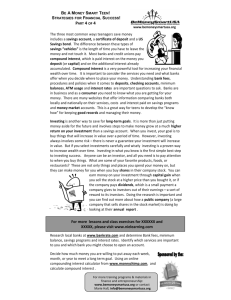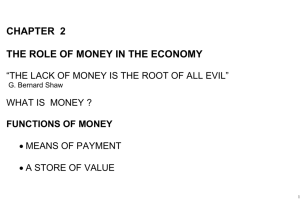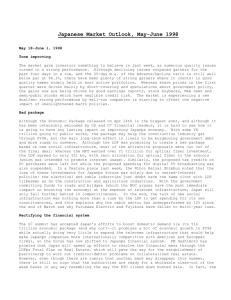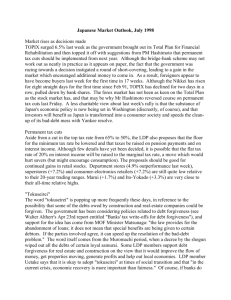Japanese Market Outlook October 1998
advertisement
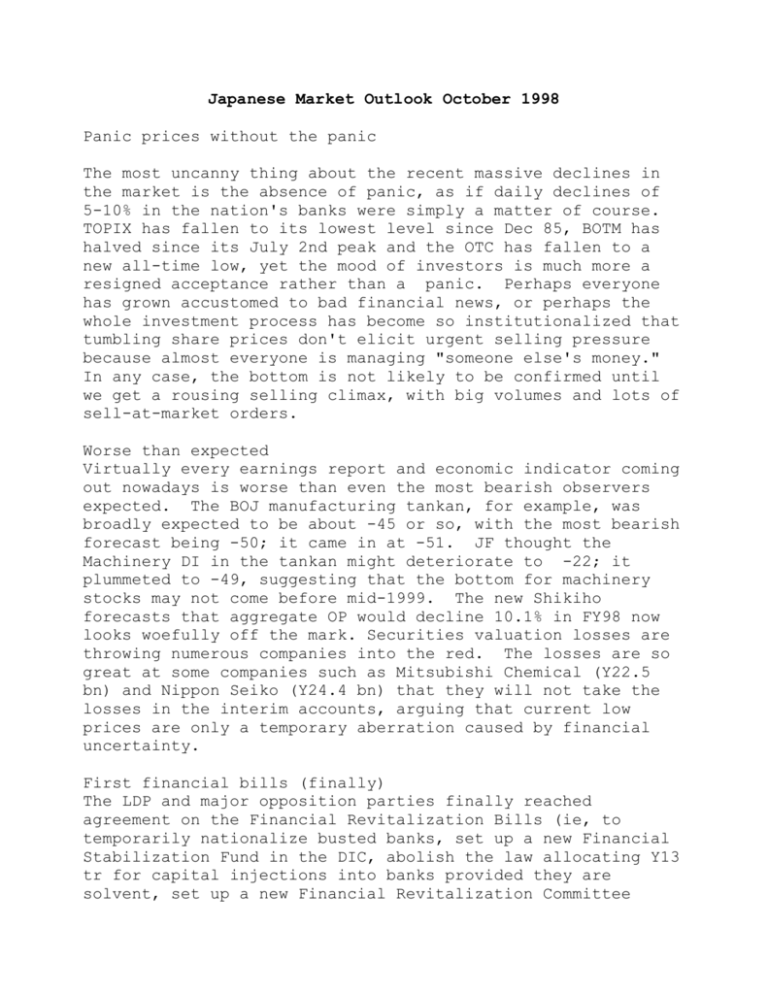
Japanese Market Outlook October 1998 Panic prices without the panic The most uncanny thing about the recent massive declines in the market is the absence of panic, as if daily declines of 5-10% in the nation's banks were simply a matter of course. TOPIX has fallen to its lowest level since Dec 85, BOTM has halved since its July 2nd peak and the OTC has fallen to a new all-time low, yet the mood of investors is much more a resigned acceptance rather than a panic. Perhaps everyone has grown accustomed to bad financial news, or perhaps the whole investment process has become so institutionalized that tumbling share prices don't elicit urgent selling pressure because almost everyone is managing "someone else's money." In any case, the bottom is not likely to be confirmed until we get a rousing selling climax, with big volumes and lots of sell-at-market orders. Worse than expected Virtually every earnings report and economic indicator coming out nowadays is worse than even the most bearish observers expected. The BOJ manufacturing tankan, for example, was broadly expected to be about -45 or so, with the most bearish forecast being -50; it came in at -51. JF thought the Machinery DI in the tankan might deteriorate to -22; it plummeted to -49, suggesting that the bottom for machinery stocks may not come before mid-1999. The new Shikiho forecasts that aggregate OP would decline 10.1% in FY98 now looks woefully off the mark. Securities valuation losses are throwing numerous companies into the red. The losses are so great at some companies such as Mitsubishi Chemical (Y22.5 bn) and Nippon Seiko (Y24.4 bn) that they will not take the losses in the interim accounts, arguing that current low prices are only a temporary aberration caused by financial uncertainty. First financial bills (finally) The LDP and major opposition parties finally reached agreement on the Financial Revitalization Bills (ie, to temporarily nationalize busted banks, set up a new Financial Stabilization Fund in the DIC, abolish the law allocating Y13 tr for capital injections into banks provided they are solvent, set up a new Financial Revitalization Committee which will oversee the FSA and be indepedent of MOF, strip out MOF's financial oversight responsibilities by Jan 2000, etc). These bills, however, represent only a first step, and the parties are now trying to thrash out a Quick Restoration of Health Scheme, which will set standards (mainly equity ratio targets) to determine whether a bank will get public capital and whether it will be temporarily nationalized. The main points of disagreement are whether banks with an equity ratio of 8% or more can get public capital (LDP says yes, DPJ says no) and whether banks will be required to mark their stock portfolios to market (LDP says no, DPJ says yes). Mating season Last week brought a rash of tie-up announcements (Tokai + Asahi, DKB +JP Morgan, IBJ + Daiichi Life, STB to join the Daiwa + Sumitomo Bank alliance, Kokusai Securities + Sakura + Deutschebank), but share prices went down anyway. The AsahiTokai tie-up gave investors the impression that the two banks were even weaker than thought, so both tumbled. Asked why they did not include Daiwa Bank in their super-regional alliance, an insider said that doing so would bring all three banks down! IBJ is likely to get at least Y100 bn in new capital from Daiichi, but it looks as if the tie-up with Nomura will move to the sidelines. To stop the landslide in share prices, MOF has proposed stricter rules on shorting and stricter penalties on rumor-mongering. Although forbidding any short sales to take place on a downtick may slow down the speed of decline, such a rule is unlikely to change the market trend. And although the spreading of false rumors is clearly unethical, the problem for the authorities is that many rumors have turned out to be closer to the truth than the disclosure by banks. Fallout from Japan Leasing Following comments from Cabinet Secretary Nonaka that LTCB should not be allowed to forgive loans to its three big nonbank affiliates, Japan Leasing applied for bankruptcy last Sunday night (Sep 27th). The bankruptcy was murder for trust banks, which underperformed TOPIX last week by a massive 17.5% to fall to yet a new all-time relative low, and volumes in the big three trust banks reached new weekly records. Off-hours trading, which had quieted down to Y37 bn on Sep 25th as financial institutions completed preparations for the closing of 1H books, exploded to an average of Y450 bn in the three days after Japan Leasing filed. Agricultural-related financial firms have over Y350 bn in loans to Japan Leasing while life insurers have a similar sum, but with inferior collateral. Given that life insurers are also overweight in bank shares and that declining interest rates are very negative for them, there may be more bankruptcies there before long. The major beneficiary from the demise of Japan Leasing is ORIX, which is likely to cherry-pick some of the better assets as it did following last year's bankruptcy of Crown Leasing. Absolute strength Just because a subsector is at a relative high does not mean that it is performing well in absolute terms. For example, Sythetic Textiles outperformed by 0.6% last week to reach a 13-year relative high, but Toray is threatening to fall below its bear-market low of Y491 (Jun 95) while Kuraray has has dropped below initial support at its 13-week m.a. The Beer sector is at an all-time relative high, yet all three stocks are buried below declining moving averages. Secom has been in a box between Y7500 and Y9000 for the past 15 months and could break out on the upside, though at 41X earnings it does not have much valuation support. Bridgestone is slightly oversold at 11% below its 13-week m.a. but an imminent dead cross suggests that it should be sold when it gets back to Y3,100. Marui, Ito-Yokado and 7-Eleven face resistance above current levels, though all are at all-time relative highs. Kao is surging to new relative highs every month, but its 13week m.a. is starting to roll over. The stock recovered from a similar breakdown in March this year, but like Secom it is on 40X. Drug stocks which are supported by rising moving averages include Takeda, Shionogi, Yoshitomi, Fujisawa, Banyu, Chugai, Taisho, Santen and Terumo. Among those, Fujisawa is likely to have the strongest growth in FY99 (OP +30%) while its PER should fall to 26.8X, according to Tanaka-san's estimates. Only a few other major stocks are above their 13-week and 26-week m.a.: Daiwa House, Sekisui House, Shobond, Kikkoman, Kagome, Fujicco, Kanegafuchi, Sumitomo Cement, Taiheiyo Cement, NGK Insulators, MCI, Suzuki, Takara Standard and the utilities. Housing-related stocks have started to outperform on hopes that the new economic package will include tax benefits on home mortgages. EP blast off The electric-power stocks have the most bullish charts in the market, with long white boxes launching off of gently rising 13-week moving averages, momentum lines turning positive and volumes at multi-year highs (especially for Chubu, Kansai and Kyushu). Note that the big moves came not two weeks ago (when new buyers still had time to collect the 1H dividends) but rather last week, after the yield on US Treasuries dropped below 5% and the price of Dec JGB futures spurted above Y139. In a way, the US and Tokyo markets are in sync: both are worried about credit quality and both are seeing plummeting interest rates, so both are seeing more new highs in the utility sector than in any other. The other sectors in uptrends in the US are energy stocks, golds and the regional bells. Japan's mining and oil sectors are scarcely comparable in either size or quality with those in the US, but both are showing signs of bottoming: the mining group has outperformed by 18.6% YTD while the TSE Oil Index has formed a double-bottom on its relative chart and is up 11.5% YTD. Whereas telephone utilities are strong performers in the US, NTT underperformed a bad market by 9.4% last week. Perhaps its fortunes will improve after Dokomo lists on Oct 22nd. Young spending down One of the last bastions of strength in the economy is coming down--consumption by the young. Ryohin Keikaku's comments that its young customer base is getting more price conscious and that demand for apparel is softening knocked the stock limit down on Friday. At 42X, there was no room for disappointment. One survey in August showed that the cohort with the greatest deterioration in confidence compared to June was consumers in their 20s, and thus the slowdown in brand goods and overseas travel. For salaried households as a whole, disposable income was down 1.2% YoY in July despite the special income tax cuts, and Chris Calderwood in his new Quarterly predicts that disposable income will decline 0.2% in CY98 and 0.1% in CY99. ________________ Market Outlook, Oct 12-16 The end of an era The stupendous declines in blue chips last week were far too big to be regarded as a mere "correction." Bear market sounds more like it. The 13% surge in yen/dollar cut the support away from most exporters, and seems to confirm the tops that were reached last summer. Recent events could be shaping up to make this the greatest turning point in the Tokyo stock market since April 1987--a month in which 25-year relative highs in financials, real estates and constructions coincided with 25-year lows in electricals, autos and precisions. At this time, there is virtually universal bullishness on the dollar vs the yen, with recent yen gains attributed solely to a temporary (but intense) demand to unwind the carry trade that has been steadily expaning since mid-1995. That's why Citibank's Telephone Center was inundated with 50,900 inquiries from late Thursday through early Friday morning. The BOJ's plans to become even more aggressive about injecting funds into the money markets helps to reinforce the bearish view of the yen. But what if this consensus view is wrong? J.P. Morgan is now predicting a recession in the US in 1999, and some economists are arguing that US short rates may have to come down by 125 to 200 bp to avert a credit crunch in the US. How many foreigners will still want to hold dollars if short rates are, say, 2.8% rather than 4.8%? Meanwhile, Mr Clinton does not seem to mind the weakness in the dollar; after all, what's good for Coca-Cola is good for the USA! TOPIX up 11.4% last week Thanks to the surge in the yen, TOPIX rose 11.4% last week in dollar terms, from $7.52 to $8.38. Although the declines in the blue chips were excruciating for domestic investors, dollar-based overseas funds actually gained 7.4% on their Sony and lost "only" 16.2% on their Honda. TOPIX itself dropped below 1,000 for the first time since 1985 and has now lost 23.3% since its recovery high on July 16th. The value of trading remains low at around Y350 bn per day, so selling pressure has not intensified: it has just shifted from banks and real estates to exporters. Overseas investors have now sold Y1.1 trillion net year to date, making this likely to be the first year that they will be net sellers since 1990. Even so, the stats show that gaijin continue to be net buyers on the OTC, a market which is at an all-time low. Why the foreigners were net sellers all through the bull market of the late 1980s and have been net buyers (until this year) all through the bear market is a fascinating topic that we must put aside until the market settles down. For the record, they bought Y66.6 bn in CY83, sold Y17.8 trillion in CY84-90 (when TOPIX rose 136.9%), bought Y21.1 trillion in CY91-97 (when TOPIX fell 32.2%) and have sold Y1.1 trillion so far in CY98 (with TOPIX down 16.4% YTD). Elements for a positive turn Perhaps we are feeling bullish because it is a bright autumn afternoon, or perhaps because the shops we visited on Saturday afternoon (Tokyo Kozo Sushi and Ryohin Keikaku) were jam packed. But there are signs that things could get better. 1) At long last, it appears that a series of financial bills to deal with weak banks will be in place by the end of this Diet session on Oct 16th. Although the Y13 trillion allocation under last spring's Financial Stabilization Law has been scrapped, the new law does not specify an amount, but the LDP may even agree to the Y50 trillion proposed by Mr Kan's DPJ. Together with the Y17 trillion for deposit protection, the government could have as much as Y67 trillion to cope with the financial crisis. 2) Although investors were impatient with the slow pace at which the Diet came to agreement on the financial bills, the result is a framework which relies more on rules than on bureaucratic/political discretion and which places more emphasis on responsibility than on the automatic bailouts favored by the old-guard LDP. 3) The next economic package could be the best one so far, since the shift of power from rural-based to urban-based politicians increases the odds that spending will focus on urban infrastructure, housing, information infrastructure and education/welfare facilities rather than roads and bridges. The Japanese people were betrayed by Mr Yamasaki last spring, who kept promising that the Y16 trillion package would focus on information infrastructure, but then allowed the spending for optical fiber and the PC tax cuts to be cut out of the final deal. This time we have not only a very malleable PM Obuchi who is espousing a program to double the citizenry's living space, but also his Economic Strategy Committee (led by Asahi Beer Chairman Higuchi) which is recommending tax exemptions on mortage interest payments, the full depreciation of information equipment in the year of purchase and a two-year abolition of the acquistion and registration taxes on real estate. 4) Total spending in the package could be as high as Y30 trillion, to ensure real 'mamizu' spending of Y10 trillion. 5) In an effort to ensure that the tax cuts are spent instead of saved, the LDP has expressed support for the Komeito idea to issue shopping coupons of Y30,000 per person which will be valid for a limited time only. Although it is likely that a significant percentage of the coupons would merely replace cash spending, the fact that the government would go to the expense of issuing coupons sends a message that it is trying to encourage spending rather than saving. 6) Finally, Japan's actions should start having a positive impact on Asia. The Emperor's and prime minister's apologies to South Korean President Kim for Japan's colonial rule of the Korean peninsula from 1910 to 1945 were followed by Mr Kim's promise that the South Korean government would never bring up the subject again. Japan has also earmarked $30 bn to help Asian economies (the Miyazawa Plan) and has advocated the use of joint oil-storage facilities with Asian neighbors. Combined with an expected pickup in domestic demand and the gains in the yen, conditions in Asia may brighten a bit. Relative trends A study of long-term relative charts suggests that the market may have made its biggest turn since the spring of 1987, when the banks and asset stocks hit their relative peaks and the blue chips hit major relative lows. Based on those charts stock groups can be divided into several categories, as outlined below. NEC scandal This week's Toyo Keizai suggests that the real motive of the prosecutors in the NEC/Defense Agency scandal is to root out more of the old 1955 system elements of collusion between the corporate sector and the bureaucrats. To that end, 30 prosecutors have been to assigned to the case, about the same number as earlier assigned to the MOF excessiveentertainment scandals. By starting with smaller players like Toyo Telecom and then working up through NEC, the proscecutors expect to uncover evidence of collusion and perhaps pay-offs by NEC to JDA bureaucrats and politicians. The key man in NEC appears to be Hiroshi Ichiryu (75), who has been an advisor to NEC since 1964. By using the contacts made when he was secretary to a former LDP chairman of the lower house, Ichiryu was able to win big computer orders from police departments and local governments in the 1970s. He also boosted NEC from being the #7 defense contractor in 1981 to #4 in 1990, and the prosecutors are suspicious that bribes may have been paid to three politicians with JDA connections: Mr Tamura (now in Ozawa's Liberal Party), Mr Yoda (LDP) and Mr Suzuki (LDP). Having succeeded in unearthing evidence of excessive collusion between financial institutions and MOF, the prosecutors are using this case to show that the taxpayer will no longer be sacrificed for cozy relations between contractors and government agencies. Unfortunately, NEC has been cut off by several government agencies for one to three months, and it must only hope that the scandal can be wound up quickly, otherwise it coud still be in the penalty box when new orders start being placed under the next economic package. In FY96, NTT and local governments accounted for 19.4% of NEC's total parent orders and 44% of its telecoms orders. ______________ Market Outlook, Oct 26-30 Get shorty Having taken all that it could stomach in plunging bank shares, the government implemented a new law from last Friday which puts greater restrictions on the shorting of borrowed shares. Although the TSE was still clarifying the rules as of Thursday night, the main features are that short sales must be disclosed as such before the order is put into the market and that short sales can no longer be made on a downtick (and may not be executed at the opening price if that price is below the previous day's close). The new law also specifies that it is the responsibility of both the person placing a SELL order and the person receiving it to confirm that the share certificates are available for delivery, with violators subject to Y300,000 fines. Thus fund managers now have another piece of red tape to go through, ie, confirm with their stock-lending departments that the shares they wish to sell are not lent out. Uncertain about the new rules, some stock lenders called in shares while other stopped lending for the time being, thus creating some buy-back pressure on outstanding short positions. In addition, a good number of short positions were closed out of fear that the lenders might suddenly call in the shares at any time. While this was going on, some positive news was coming out on the banks, such as the plan to adopt tax benefit accounting (which would add Y5 tr to banks' capital) and IBJ's initiative to apply for public capital. As a result, some overseas funds which have been underweight Japan started investing in bank stocks, and the shares of six banks soared by over 30% last week. Volumes surged to new weekly records for IBJ, DKB, Asahi, Mitsubishi Trust and Sumitomo Trust. Sakura (113.6 mn shs) and Fuji (83.8 mn shs) were the two most active stocks on the market last week (except for LTCB), but neither reached the record volume set in the first week of September. Note that volumes peaked last Wednesday, and had subsided considerably by Friday, suggesting that the peak in buying pressure has passed. JF remains staunchly negative on bank shares. Public money for banks Several banks have followed IBJ's lead in revealing that they now plan to apply for public funds, even though the method of injecting the funds has not yet been decided. Last week the Nikkei Financial reported that subordinated bonds and loans were not likely to be issued, since they are not counted in BIS equity ratios, thus leaving forced convertible preferred securities (which could lead to heavy dilution of common shares) or straight-bond type preferred securities (where the coupon is likely to be hefty) as the two most likely methods. Without knowing what type of public money IBJ will be receiving, it is hard to see why its decision to apply should add 36.6% to its market cap. Meanwhile, the Asahi Shimbun reports that Y500 bn of the Y1.8 tr in capital injected into 21 banks last March was actually sourced from ag coops and regional banks at the short-term prime rate (1.625%) rather than from the BOJ (at the ODR of 0.50%) or MOF (at the cost of issuing JGBs, or around 1%). That Y500 bn could have otherwise been lent to small companies, so it had no impact in easing the credit crunch. Apparently, the DIC had to procure the funds from those private sources because MOF was reluctant to issue the JGBs and BOJ did not want to impair its balance sheet. If they were that tight back in March, how confident can we be that the promised Y60 tr is actually going to be made available to the banks? A super regional? Daiwa Bank put in some overtime this weekend, revealing that it will 1) form a tie-up with Bank of Kinki with the aim of becoming a super regional bank in the Osaka area, 2) withdraw from overseas business and thus get by with a 4% equity ratio, thereby freeing up to Y430 bn to write off bad loans, 3) apply for Y200-300 bn in public funds as a white knight suitor for the struggling Bank of Kinki, 4) raise another Y50 bn from Nomura and other Kansai companies, 5) cut salaries by 10% across the board, and 6) cut the workforce from 8,091 in Mar 98 to about 7,000 by Mar 01. Their plan contains two ideas which may well be copied by other banks in the weeks ahead: give up on overseas banking to get by with less equity, and adopt a small regional bank to qualify for public money as a savior rather than as a misfit. Daiwa's share price should rise further, since it is cheap on a stated PBR of 0.6X and its downsizing allows it to clean up its balance sheet at a more rapid pace. Telecoms weighting The listing of NTT Dokomo has added over Y8 tr of value to the TSE's market cap, and boosted the weighting of the Communications sector from 2.89% (Y7.67 tr) on Oct 21st to 5.87% (Y15.3 tr) on Oct 23rd. The TSE does not count the NTT shares still held by MOF (65.4%, or 10.4 mn shs worth Y10.1 tr) as part of market cap, but NTT's weight in TOPIX will go up by Y974 bn if the fourth tranche of shares is sold to the public in December at Friday's closing price. That would bring the Communications sector up to 6% of market cap, making it comparable to the sector's 7% weighting in the S&P 500. The doubling of the communications sector's weighting in TOPIX virtually ensures that institutional investors will continue to build positions in NTT and Dokomo. NTT, which made an extraordinary gain of Y824 bn on the sale of 218,000 of its Dokomo shares, has indicated that it will return Y200 bn of the gain to shareholders. Although it was earlier reported that NTT would buy back Y200 bn in stock, the plan now is to buy back Y120 bn in shares (ie, roughly 12% of the next tranche) and to pay a special dividend of Y80 bn. Undoubtedly, its hard-up major shareholder would much prefer a cash dividend to a share buyback. MOF can count on Y52 bn of dividends on its own shares plus Y5/6 bn on everybody else's (ie, the 20% tax levied on dividends). Electricals outperform The SPE sector continued to outperform (by 4.1% last week), and may continue to rise as more US analysts upgrade the US SPE stocks. NEC (+18.7%) rose through the week, but accelerated its gains on Friday after Chairman Sekimoto announced that he would resign to take responsibility for the Defense Agency scandal, which has led to the arrests of over ten NEC group employees. (He will not, however, vacate his office.) Fujitsu (+13.1%) advanced after it revised up its consolidated net estimate for Mar 99; its 1H sales rose 6.6%, it enjoyed Y41 bn in extraordinary gains from the listing of subsidiaries and it is likely to pick up some domestic telecom equipment and computer orders while NEC suffers a ban on local government procurements. Toshiba (+8.7%) surpassed Hitachi's share price for the first time in 35 years midweek, but Hitachi (+11.4%) rallied on Friday on news that it will have Hitachi Credit set up a securities firm to help group companies securitize their assets. Meanwhile, Tokyo Seimitsu (+44.6%) shows that investors can still dream. Diet in December An extraordinary Diet session has been called for December in order to put together the next economic package, which is likely to include Y10 tr of real (mamizu) spending, bigger income tax cuts, tax cuts and deregulation for real estate, and a focus on 21st century public works such as information infrastructure, housing, widening of roads and education/welfare facilities. The LDP has been making overtures to the Liberal Party and the re-merged Komeito, and seems willing to go along with their pet projects (an expansion of the loan guarantee system desired by the Liberals and the shopping coupons desired by Komeito), but the main stumbling blocks are Mr Obuchi's low ratings in the polls and the LDP's constant assertion right up to the last day that LTCB was solvent. Technical picture The market ran into its first line of resistance morning at 14,742, then dropped 597.74 points to close of 14,144.70. Important resistance points the Aug 92 low of 14,309, 2) the 13-week m.a. of on Thursday Friday's include 1) 14,532, and 3) a one-half retracement of the decline from Jul 16th to Oct 9th, at 14,806. Foreigners became net buyers (Y68.4 bn) in the week ended Oct 16th, when TOPIX rose 2.5%, but they were apparently buying the blue chips which got hammered in the previous week rather than banks, which beat TOPIX by a mere 37 bp in that week. In terms of TOPIX, the current (six-day) gain is 9.0%, making it similar to the earlier 1998 rallies (+16% Jan 12th-Feb 10th and +8.5% Jun 17th-Jul 16th), rather than some of the 30% rallies we saw between 1992 and 1997. To achieve a 30% rally, it is essential to get above the 13wk and 26-wk moving averages, and to stay there long enough to start pulling those moving averages into an uptrend.


